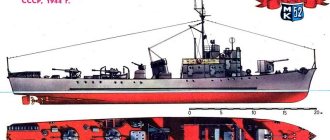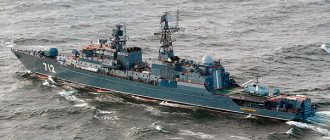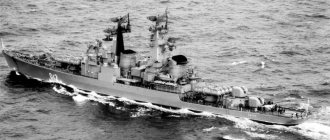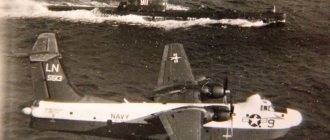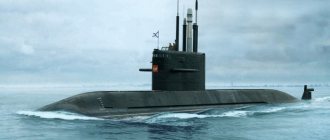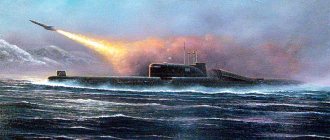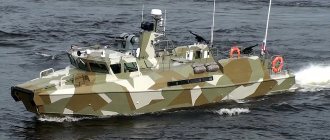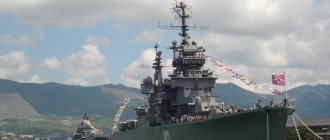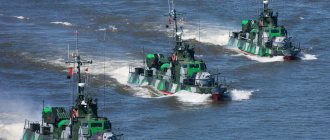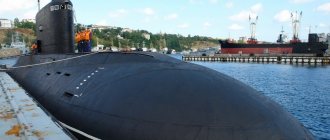Home » Alternative History (fiction of this genre) » Kirov Spring. Project 7 destroyers are alternative weapons.
Alternative History (fiction of this genre)Alternative History (fiction of this genre)
Dmitry Yu 01/20/2017 830
0
in Favoritesin Favoritesfrom Favorites 0
I must say that I do not like Project 7 destroyers. They are too weak and have too weak air defense. However, Italian technical assistance was the only real technical assistance, which means that no other large-scale destroyer could have been born in our country in the thirties.
In my previous materials, instead of Project 7 destroyers, I proposed the construction of Ladny-class leaders. However, now I want to offer a different vision of the situation
In general, it seemed to me more historical to leave all, without exception, pre-war projects, including the destroyers of Project 7, unchanged, except for the following: the Red Army Navy has been armed with licensed 100mm Minizini universal guns and 40mm Bofors automatic guns, mass-produced in the USSR since the mid-thirties
Of course, there will be no Project 7U - but all laid down destroyers will be completed
in the text it looks like this:
The Great Patriotic War
At the beginning of the Great Patriotic War, the Soviet Navy had 22 destroyers of project number “7”. The remaining 25 destroyers, although they were laid down back in 1935-1936, for one reason or another, were not commissioned by contractors (shipyards). All destroyers of project number “7” and its modernized version “7U” were divided into 4 fleets:
- Baltic Fleet;
- Black Sea Fleet;
- Northern Fleet;
- Pacific Fleet.
However, due to strategic objectives, destroyers played a role in the first two fleets.
Baltic Fleet
The Baltic Fleet included one detachment of light forces and one squadron, consisting of destroyers of project numbers “7” and “7U”, as well as other ships of various classes. The destroyers “Storozhevoy”, “Glorious”, “Stokiy”, “Angry”, “Severe”, “Strong” were included in this list (upon completion of construction they were supplemented by new “sevens”). Despite the fact that basically all of these warships were disabled by fascist forces, some of them achieved real success in achieving victory for the Red Army.
For example, the destroyer Slavny was able to cover a total distance of 3,700 nautical miles and fire about 2,000 artillery shells from its main and anti-aircraft guns. Another example is the destroyer Stoiky, which sailed more than 7,500 nautical miles. Moreover, the latter not only carried out strikes (more than 1,500 shells) on enemy units, but also successfully used mines (about 300 units), depth charges (about 130 units) and transported more than 1,500 troops. “Strong” and “Angry” participated directly in the naval battle against the German naval group and achieved success in it. The destroyer "Surovy" also participated in another naval battle in the Gulf of Riga, where, like its brothers "Strong" and "Angry", it achieved success.
Black Sea Fleet
The Black Sea Fleet consisted of two divisions, but only one had destroyers of project numbers “7” and “7U”. The second division included the destroyers “Bystry”, “Svobodny”, “Smyshlyny”, “Soobrazitelny”, “Sposobny” (over time, the ranks were supplemented by new destroyers of project numbers “7” and “7U”). The main task of the fleet was to protect Odessa and Sevastopol. Moreover, in the following year the fleet supported landing operations in Feodosia.
The legend of the Black Sea Fleet is the destroyer of project number 7 - Soobrazitelny. The latter went through the entire war without receiving a single significant injury and losing only 5 crew members. In total, the "Smart" traveled more than 60,000 nautical miles (engaging in 218 combat missions). Over 4 years, the destroyer fired almost 3,000 artillery salvoes, transported about 15,000 military personnel, shot down 5 Nazi bombers and towed more than 50 pieces of naval equipment. Moreover, the combat ship and its entire crew were awarded the “Guards” title for excellent successes in the Feodosia Landing Operation in 1941. As experts of that time said, the main success of the Soobrazitelny was the synchronicity of the ship’s commander, Captain 1st Rank N. Basisty, and the crew of the destroyer subordinate to him, a legend.
Post-War Time
After the end of World War II, most of the destroyers of project numbers “7” and “7U” were decommissioned. They were replaced by new and more modern at that time destroyers of project number “30 bis”. The main reason is military-technological progress during the Great Patriotic War. The new destroyers were fully automated and equipped with the latest installations such as radar, sonar, etc.
05/24/40 Izvestia newspaper.
Military operations in Western Europe
BERLIN, May 23. (TASS). The German Information Office transmits the following message from the German High Command:
“Our troops, advancing in Flandria beyond the Scheldt, encountering strong enemy resistance, are slowly seizing territory. Fighting takes place near Valenciennes. The wooded area near Mormal, southeast of Valenciennes, has been cleared of French troops holed up there. Yesterday, with the cooperation of ground forces and aviation, attempts by enemy armored units to break through the front near Cambrai were repulsed, and heavy losses were inflicted on the enemy. In the western part of Artois (Pas-de-Calais department), German troops are moving north towards Pas-de-Calais. Along the front from the Somme to the Meuse the enemy is resisting. In the fortress of Liege, the recently rebuilt Fort Battis surrendered to our troops, and twenty officers and 650 soldiers were captured. On the front south of Namur the enemy still holds some fortifications.
German air attacks were aimed primarily at communications and retreating enemy troops, as well as at rear concentrations of troops in Flanders and Artois.
Army reconnaissance aircraft operating on the English Channel sunk three transport ships and one oil tanker with a total displacement of about 20,000 tons. One enemy destroyer was seriously damaged. Warehouses in the ports of Dunkirk and Dover were successfully bombed. The rapid-fire guns of the German fleet sank an enemy destroyer in front of Dunkirk. Aviation operations on both sides were limited by meteorological conditions. The enemy lost nine aircraft. Five German planes did not return to their bases.
A battleship was damaged near Narvik. One transport ship with a displacement of 3,000 tons was sunk and another was damaged. In addition, warehouses of military materials and ammunition were set on fire. Columns of enemy reinforcements are scattered. Attacks against coastal batteries and embankments were successfully carried out.
Last night the enemy again launched indiscriminate air attacks on non-military targets in Germany.
In Holland, British planes raided the towns of Nijmegen and Waalwijk. Several civilians were killed. As already reported, during the period from May 10 to May 15, 342 enemy aircraft were shot down by anti-aircraft artillery.”
*
LONDON, May 23. (TASS). Reuters radio reports that, according to an official statement published in London last night, British troops maintained their positions throughout May 22. English troops launched counterattacks in the area between Arras and Douai. Belgian troops successfully attacked German units, which crossed the Scheldt River in two places. According to information received in London from Paris, a major battle took place yesterday between Cambrai and Valenciennes. British troops operating in this area dealt a crushing blow to the flank of German units near Cambrai. French forces approach Amiens. Between Arras and the Somme, as well as north of the Somme, the situation remains uncertain. Light German motorized motorcycle units are trying to destroy Allied communications. Significant French forces concentrated along the Somme and Anne continued to hold their positions firmly yesterday.
LONDON, May 22. (TASS). An aviation columnist for the Daily Telegraph and Morning Post refutes a German report that Allied air losses have averaged 120 aircraft per day since the start of the German offensive on the Western Front. The British air force, the observer continues, took a large part in air operations, and the daily losses of British aircraft did not exceed 40 units.
*
New in modern warfare
Airborne assaults
In modern imperialist warfare, one of the new forms of warfare is the use of airborne assaults. Having started the war, the German command immediately tried to use airborne assaults as a fighting force. The Allies still do not use airborne troops, although they wrote a lot on this issue in peacetime.
The use of airborne assaults by the Germans in the current war can be divided into three stages:
The first is the war in Poland. During combat operations in Poland, the German command used a small number of parachute groups. The task of the parachute landings dropped in the rear of the Poles was to disorganize the rear of the Polish army and inform the command about the number of enemy troops in a particular area. The German parachute landings dropped in Poland had limited missions. This was the first attempt to use a new branch of troops in the outbreak of war.
The second stage of the use of airborne assaults in modern warfare refers to the German military operations in Danni and Norway. In these operations, the German command took into account the lessons of the airborne operations in Poland and used airborne assaults in a completely new way. Airborne troops were landed directly on enemy airfields, near objects of great strategic importance. The troops that landed at the airfields immediately spread their actions to nearby areas, thus providing the opportunity to organize further landings of airborne troops.
Thus, active German units were created behind enemy lines. The military attaché of one of the neutral countries, who was in Oslo, told a Paris Soir correspondent the following details of the seizure of the Oslo airfield by a German airborne assault: “Immediately after the Norwegian government rejected the ultimatum of the German command, German planes with troops landed at the Oslo airfield, and the fighting began. In 2 hours, 1,500 soldiers armed with automatic rifles, machine guns and light cannons were landed at the airfield. Motorcycles were also unloaded along with the troops. The approach of the squadrons to the airfield was carried out in formation of 5 aircraft, and 2-3 aircraft landed simultaneously. The planes covering the airborne landing fired machine guns at the surrounding areas adjacent to the airfield.”
In subsequent operations in Norway, airborne assaults were used as effectively as in the first operations. In order to destroy the Dombos railway junction, a parachute assault force was landed in the Dombos area. Airborne assaults provided especially great assistance to the troops fighting in the Narvik area. Until the last days, reinforcements and ammunition were sent there by air.
Operations in Norway showed that the effectiveness of airborne assaults largely depends on their mass use, on the ability to expand the area of operation of the landed troops, as well as on the ability to organize ammunition supply and reinforcement during combat operations.
The third stage in the use of airborne assaults is the general offensive of German troops in Belgium and Holland, as well as in France. According to foreign press reports, airborne units of two German air divisions operated in Holland and Belgium. This time the German command used large formations of airborne troops. The airborne assault forces were assigned the following tasks: to seize enemy airfields, destroy communications, disorganize the enemy rear and, finally, assist friendly troops in capturing fortified points.
As can be seen from the course of military operations, the German airborne assaults completed this task.
The first group of German paratroopers was dropped in Holland on the morning of May 10. Parachute landings occupied the areas of Naarden, Zooburg, Sladrecht and the Walhaven airfield. In the future, German planes were apparently able to land at the Walhaven airfield.
At the same time, parachute troops were landed in the area of Hogeswaluw, Leiden and the Frisian Islands. At night and at dawn on May 11, airborne troops were landed in the area of Amsterdam and Rotterdam, and troops were also dropped in the area of Goudz, Boxtel, Dobrecht and Moerdijk.
Thus, almost throughout Holland, German troops found themselves in the rear of the army. The landed airborne forces held out on enemy territory for 4 days, holding important strategic points until the main German troops arrived. At Moerdijk, landing troops captured the railway bridge over the Meuse River and held it, allowing the troops to cross. In Holland, airborne assaults accomplished the critical task of preventing flooding.
According to the English Daily Herald, the Germans dropped 12 thousand paratroopers in the Amsterdam-Rotterdam-The Hague triangle on the first day alone. This forced the Dutch command to allocate significant troops to counter the German landings. In modern warfare, this is the first time that an airborne assault landing behind enemy lines completed the combat mission assigned to it and linked up with the approaching troops.
Simultaneously with the landing of airborne troops in Holland, the latter were landed in Belgium. Parachute landings landed in the areas of Nived, Saint-Tron, Liege, Eben Emael and the Albert Canal. On May 12, an airborne assault was landed in Vilvoord (15 km from Brussels).
During the assault by German troops on Fort Eben Emael, the parachute landing provided great assistance to the troops. Paratroopers descended directly into the fort area and, using hand grenades, assisted the troops in capturing this fort. As you know, the garrison of this fort capitulated.
It can be assumed that two divisions of airborne troops operated on the front of Belgium and Holland. The organizational structure of large formations of German airborne troops is emerging. In Germany there are two types of airborne troops: parachute landing troops, air transport troops. Both groups of airborne troops have close cooperation during combat operations.
If the situation allows, the landing force lands directly on the enemy airfield, otherwise a parachute assault force is sent out, which captures the airfield and ensures the landing of airborne assault aircraft. The landed airborne troops are gradually replenished and expand their area of operations (depending on the situation).
Airborne assault forces take part in attacks by ground troops on fortified points, and also supply ammunition and manpower to units operating in isolation from the general mass of troops (Narvik). In addition, it is noted that the airborne landing is covered from the air (air supremacy is necessary).
Despite the successful actions of the German airborne assault forces, their combat value cannot be overestimated. What was possible in Belgium and Holland may not be possible in other countries. The German offensive in France has not yet been accompanied by mass airborne landings. There were only two reports of German landings beyond the Maginot Line, but nothing is still known about the actions of this landing.
The advantageous position for airborne landings in Belgium and Holland was due to the fact that these countries were not in a state of war and therefore surprise could be counted on. The use of airborne assault forces must be based on strict consideration of the specific combat situation and the overall operation plan. Against the backdrop of the airborne landings, the method of combating them also emerges. The main enemy of airborne troops is aviation. If aviation promptly detects the beginning of a landing, it will be able to immediately destroy it.
Airborne assaults appeared long before the current war, but their use on such a large scale had never been practiced before. In the Dutch and Belgian theaters of war, parachute landings in cooperation with ground troops fully justified themselves.
Captain S. SOKOLOV
Dive bombers
Dive bombers were first used in large numbers during the German-Polish War. Their well-aimed attacks were aimed at railway junctions, bridges, highway intersections, radio stations and headquarters. The destruction of these objects greatly complicated the mobilization of the Polish army, disrupted transportation, and complicated command and control. The rear of the Polish army was so shocked that until the end of the war the Poles were unable to regroup their forces.
Dive bombers provided significant assistance to ground forces. In places where the advance of motorized mechanized troops was delayed, aircraft were called for help by radio. Joint strikes by dive bombers and ground troops against pockets of resistance quickly cleared the path for the latter to move.
In combat operations on the Western Front - in Holland, Belgium and Northern France - German dive bombers assist the advance of their troops by striking enemy firing points and batteries. They also attack columns of tanks and troops approaching the battlefield. Dive bombers are actively operating against Allied ships at sea. It is known that the English battleship Warspite was disabled by them off the coast of Norway.
The experience of the European war shows that dive bombers are a new and very effective weapon, and dive bombing is one of the main methods of action of bomber aircraft. However, in many air fleets this new weapon was underestimated until recently.
What is dive bombing? The increased speed and altitude of modern combat aircraft significantly complicate the work of the crew. The increasing effectiveness of air defense systems makes it necessary to conduct bombing attacks at high altitudes, at maximum flight speed and using anti-aircraft maneuvers. As a result, bombing accuracy decreases. True, bombing devices are also being improved, but this still does not give the desired results. How bombing conditions change can be illustrated by the following example: a delay in dropping bombs by 0.5 seconds. at a field speed of 150 km per hour, it gives a deviation from the target of 20 m, while at a flight speed of 600 km per hour it increases to 80 m. The higher the bombing altitude, the greater the deviation of the bombs from the target. The classic method of bombing from horizontal flight when attacking small targets from high altitudes requires a large consumption of aircraft and bombs.
All this forced us to look for new, more effective methods of bombing. One way to improve bombing accuracy is dive bombing. This method was known back during the war of 1914-1918. But increased attention has been paid to it only since 1927. Dive bombing increases hit accuracy (two to three times) and is safer than horizontal bombing in the anti-aircraft artillery fire zone. Dropping bombs from a dive increases their destructive power. This is especially important when attacking structurally sound targets. When diving, it is possible to fire at the target with cannon and machine gun fire.
A dive is a steep descent of an aircraft at large angles to the horizon. Aiming is carried out by aiming the entire aircraft. Since the aircraft flies in the direction of the target, its angular velocity relative to the target decreases significantly. At the same time, errors in determining flight speed, altitude and direction of flight have a much smaller impact on the accuracy of bombing. The aircraft does not drop bombs at a certain distance from the target, but rather “shoots” bombs at the target. All this makes it possible to hit small objects.
Freedom of maneuver when approaching a target and the high speed of the aircraft during a dive reduce losses from anti-aircraft fire. At the moment of dropping the bomb already has an initial speed equal to the speed of the aircraft. Increasing the bomb's flight speed increases its penetrating effect.
All these features of dive bombing make it very effective in modern warfare. At the front and in the rear there are small but very important objects. These include long-term firing points, batteries, columns of motorized mechanized troops, railway junctions, bridges, highway intersections, and industrial enterprises. Dive bombers are of particular importance when operating at sea. The very nature of the targets, the small size of the ships and high strength make it necessary to use dive bombers against them. Only they allow you to combine the accuracy of a strike with the high penetrating ability of an aerial bomb.
However, along with the advantages, dive bombing also has a number of disadvantages. An attack on a target can only be carried out by small units, which makes it possible for enemy fighters to attack small groups or single aircraft.
Dive bombing requires the use of special types of aircraft. At the beginning of the imperialist war, the German air fleet had special air units of dive bombers. They were armed with Junkers 87 and Heinkel 123 aircraft. A long dive and recovery from it are associated with large overloads of the aircraft. Hence the requirement for an aircraft to have a large margin of safety. A high dive speed causes the propellers to spin up, requires dropping bombs from a high altitude (since it is necessary to have a reserve altitude to recover from a dive) and increases the radius of the aircraft's recovery from a dive. To reduce the dive speed, air brakes (flaps) and reversible propellers are used.
Technical thought successfully resolved the difficulties associated with diving. We can expect that in the near future dive bombers will receive new improvements and will firmly enter the system of the air fleets of all countries.
Captain N. KRAINEV.
{1}
The history of the creation of destroyers of project number “7”
In connection with the country's new ambitions, the Command of the Red Army Naval Forces needed to update the outdated fleet. The first work on a new type of destroyer began in the late 1920s, but due to financial difficulties the process stood still. Only in the early 1930s was the Central Design Shipbuilding Bureau created, which was responsible for the design of new destroyers. The main requirements for the bureau were:
- The construction of destroyers was supposed to be inexpensive and quick;
- The new destroyers were supposed to be no worse than their “brothers” from other countries.
The main persons responsible for the design were V. Nikitin (project manager) and P. Trachtenberg (project executor). The Central Bureau decided to turn to Italian shipyards for help in creating a new type of destroyer. There were two reasons for this:
- Italian Maestrale-class destroyers (built by the shipbuilding company) evoked positive reviews from the Soviet leadership;
- Friendly relations between the Soviet Union and Italy.
Maestrale 1942
Shipbuilding gladly accepted TsKSB's offer and decided to help our engineers. In connection with this turn of events, the silhouette and design of the hull of the new destroyer was predetermined. A delegation consisting of members of Soyuzverf and the Command of the Red Army Navy went to Italy. provided all the necessary documentation and drawings, and also gave Soviet engineers access to the shipyard.
After three months of joint work by Soviet-Italian engineers in the fall of that year, the Main Revolutionary Military Council accepted the model of the new destroyer. According to its features, project number “7” was supposed to have a displacement of about 1,300 tons, a maximum speed of 40 knots and a maximum range of 1,800 nautical miles. It was planned to equip the destroyer with 4 130 mm artillery guns and 3 76 mm anti-aircraft guns, as well as 2 533 mm torpedo tubes. Moreover, in general it was designed according to the Italian style - the destroyer had a linear main power plant and a single-tube hull.
Selecting the optimal configuration
Due to the incomprehensibility of the desires of the command and the reality of the country's capabilities, the project was revised and redone. Firstly, the level of technology and the lack of necessary equipment forced TsKSB to move away from the Italian prototype. Secondly, the desire to build a more powerful combat vessel, but with a smaller displacement, led the engineers to a dead end.
The final sketch of the new vessel was approved and signed by the Council of Labor and Defense in 1934. The technical data of the vessel should have looked like this: displacement - from 1430 tons to 1750 tons; length – 112 m; width – 10.2 m; maximum speed – 38 knots; staff – 170 people; armament - 4 130 mm artillery guns, 2 76 mm anti-aircraft guns and 2 three-tube torpedo guns. It is necessary to note an important fact - at that time, much of the guns and equipment existed only in the plans of engineers, and the layout of the ships did not have any spare displacement.
Construction and testing
The construction of destroyers of project number “7” was divided between 4 main and 2 auxiliary shipyards of the country.
The main shipyards were:
- Shipyard No. 189 named after. Zhdanova;
- Shipyard No. 190 named after. Ordzhonikidze;
- Shipyard No. 198 named after. Marty;
- Shipyard No. 200 named after. 61 Communara.
Auxiliary shipyards were:
- Shipyard No. 199;
- Shipyard No. 202;
The main task of which was to assemble ready-made parts of the destroyer on the shores of the Pacific Ocean.
Construction began in 1935, and almost all other destroyers were laid down the following year. However, despite the fact that at the beginning of the company everything went according to schedule, over time the construction lost momentum. The main reasons were the country's lack of infrastructure and personnel. Subsequently, in 1936, only 6 destroyers of project number “7” were completed.
However, the turning point in the construction of Soviet destroyers was an incident that occurred off the coast of Spain. At the beginning of 1937, the English destroyer Hunter was authorized to peacefully monitor the actions of the two sides of the Spanish Civil War (Republicans and Francoists). Early in the spring morning of the same year, the Hunter found a mine, which immediately disabled the ship's main power plant. The incident had a huge impact on project number “7” because The Hunter warship, like the Sevens, had a linear power plant. Despite the fact that by European standards the Hunter was considered a fairly durable combat vessel, the Soviet Union decided to change the design of the ship. The responsible designers - V. Brzezinski, P. Trachtenberg and V. Rimsky-Korsakov were exiled to Siberia for negligence in their work. In the end, they decided to make a modification to the ship. The main task was to change the structure of the main power plant. The modified version was the type “7U” (project number “7” improved). "7U" was modernized within a month by engineer O. Jacob.
The first vessel of project number "7" - "Bodriy" - was launched into the water in 1938. However, due to the fact that it did not reach the planned speed limit, the ship was returned to the shipyard. As a result, the first destroyer to pass tests and enter service was the Gnevny.
destroyer “Wrathful”
A total of 29 destroyers of project number “7” and 18 destroyers of project number “7U” were built. It was decided to divide the remaining 6 cases into modules and use them as spare parts. The destroyer "Resolute", commanded by the future Commander-in-Chief of the Navy of the Soviet Union S. Gorshkov, sank during launching in stormy weather and, therefore, was not commissioned by the navy.
Italian prototype
You might be interested: Does being almond-y mean showing tenderness or deceit?
At that time, Italian-made destroyers were considered the best in the world. Therefore, a group of Soviet scientist-engineers was urgently sent to Italy, whose goal was to learn from the experience of their foreign colleagues. Soviet engineers studied the documentation, observed the progress of construction and returned home with new ideas.
Design of the destroyer “Bystry”
The silhouette of project number “7” was single-tube, quite long and not very wide. Having a length to width ratio of 11:1 and high speed, the ship's maneuverability was quite low.
The ship's hull itself was made of low-manganese steel, which affected the ship's survivability. The fact is that low-manganese steel is highly hard on the one hand, but on the other hand it is very easy to crack. Even from the blows received when the ship was moored to the port, the destroyers sometimes received cracks. The above-deck structures were made of ordinary steel.
Ship's Power Plant
Project number “7” had a linear power plant. To be more precise, the ships' boilers were located in one long compartment in a single-line order. The main reason for choosing a linear type of power plant was efficiency. However, in the modernized “7U” the power plant was changed. In the latter, the power plant was located in different compartments of the ship, which in turn increased the survivability of the ship.
Famous battles
During a war, it often happens that an ordinary ordinary battle goes down in history forever. This is exactly what the battle at Cape Kanin Nos became. In the difficult year of 1942, Russia needed the help of its allies. Weapons, fuel - we received all this by sea thanks to convoys. But it was in September 1942 that Winston Churchill said that convoys should be temporarily stopped due to heavy losses. However, the country's leadership persuaded Great Britain to organize another convoy, which began moving on September 18. While in the Allied area of responsibility, he lost 11 ships. After this, Soviet destroyers took over the guard. Among them were the famous “sevens” - “Thundering” and “Crushing”. Near Cape Kanin Nos, the Germans attacked the convoy from all sides. German aircraft and submarines took part in the powerful combined attack. The fierce battle lasted two and a half hours. The convoy was attacked from the air by dozens of torpedo bombers and bombers, but all of them were met with powerful, coordinated fire. As a result of a heated battle, the convoy arrived at its destination and suffered minimal losses. Only one ship was torpedoed. The Germans lost 15 aircraft in that battle. It became clear that convoys were needed, that it was dangerous, but completely justified.
Ship Armament
The destroyer was armed with: the main gun, anti-aircraft weapons, torpedo weapons and anti-submarine weapons.
Main Weapon
The main artillery pieces were 4 130 mm cannons. The guns themselves were manufactured. The projectile speed reached 900 m/s, and the range of the projectiles was about 30 km. In total, each gun was equipped with 150 projectiles for various purposes with a weight of 33.7 kg.
Anti-aircraft weapons
The destroyer had two 34-K class guns with 76 mm as anti-aircraft weapons.
Torpedo Weapon
Two 3-tube torpedo tubes of the "39-Yu" class were part of the destroyer's armament. The torpedoes had a range of 4 km and a speed of 12 m/s.
Anti-submarine weapons
On board the destroyer of project number “7” there were from 60 to 65 mines (depending on the class of mines). Standard armament consisted of:
- 25 units of depth mines;
- 10 units of large mines;
- 15 units small min.
05.25.40 Headquarters of the Red Army Navy
— Comrades, did everyone read yesterday’s News? – the commander of the Red Army Navy Kozhanov asked the participants of the operational meeting.
— You, Ivan Kuzmich, are probably talking about dive bombers? – asked Deputy Commander for Combat Training Kuznetsov.
- About them, the bastards. What is the most effective weapon against them, Lev Mikhailovich? – he asked his deputy for shipbuilding.
— We know which one – automatic 40-mm Bofors guns.
- And how are we doing with them on the ships? – asked Kozhanov.
“Almost all ship designs are protected by 40-mm cannons,” Haller answered with satisfaction.
- So, remind me how many of them, for example, are on the new destroyers? – Kozhanov asked a new question.
“The armament of Project 7 destroyers includes four twin 100-mm universal Minisini gun mounts, four single 40-mm automatic cannons, as well as two three-tube 533-mm torpedo tubes,” Haller reported.
- Few! – Kozhanov unexpectedly stunned those gathered. Only four barrels! You need at least three times more.
- But for mercy, Ivan Kuzmich, let’s say in some cases it is possible to replace single automatic cannons with twin ones, additionally put an automatic gun on the stern, but increase the number of barrels three times, and in addition triple the ammunition load of 40-mm anti-aircraft shells, it is simply impossible, on The ship doesn't have that much space! - Haller objected.
— What if you remove the second bow Minisini? – Kuznetsov unexpectedly suggested.
- Do you see? - Kozhanov supported Kuznetsov, - what if you think about it? In a word, here is an order for you, Lev Mikhailovich: go to the designers, you have three days. Don't come back without a 12-barrel 40mm project.
Project Evaluation
The destroyers “Gnevny” (project number “7”) and “Storozhevoy” (project number “7U”) are the largest serial combat ships in the history of the Soviet and Russian fleet. Of course, the 47 destroyers built were to play a vital role in the outcome of the Great Patriotic War. However, due to the fact that all the destroyers were divided into 4 fleets, the power of such serial shipbuilding was scattered and could not prove itself.
Another important factor is the increase in USSR spending on the maritime industry. If in 1935 the country's expenses were 4.6 billion. rubles, then in 1941 this figure was 12.8 billion. rubles
Despite large-scale mass production of destroyers and increased spending on the navy, the Soviet Union was unable to properly use its naval power (dividing the navy into parts). Subsequently, the USSR was unable to become a maritime power in the post-war period.
Post-war service[ | ]
“Threatening” became part of the 4th (South-Baltic) Navy in 1946, and from December 1948 - part of the 8th (North-Baltic) Navy. In June 1952, the ship was put under major repairs, but already in August of the following year the repairs were stopped, and the ship was expelled from the Navy and scrapped.
"Steregushchy" from 1948 to 1957 was part of the 8th Navy, then the Baltic Fleet, in January 1958 it was excluded from the lists of the fleet and the following year it was scrapped.
"Bodriy" continued to serve as part of the Black Sea Fleet, in 1951-1953 it underwent a major overhaul, but already in 1956 it was withdrawn from combat service and was used as a target vessel, and in 1962 it was grounded near the Tendra Spit as a target.
"Boikiy" also remained part of the Black Sea Fleet in 1948-1951. underwent a major overhaul. Since 1956, it served as an experimental vessel and was scrapped in 1958.
“Rezkiy” was transferred to the People’s Republic of China in 1955, renamed “Fushun”, and scrapped in 1989.
